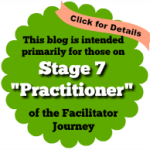Facilitation: Relax and Trust the Process


 Many of you know my love for the environment and outdoor adventure, and pushing the edges of my physical and psychological limits. In our new Victoria, BC, Canada environment by the sea, I have decided to make the sea my friend and playmate. I am getting to know it as best as I can. Thus, I took a recent Level II Paddle Canada Sea Kayak training of 32+ hours. My competency vastly increased and even though I did not pass the course, I learned to be intrepid (i.e., not give up on myself). The excellent instructor was kind and patient with me, as I was the weakest of the four of us who were taking the course. He gave me a “medium level” pass for level I paddling. I did not care whether I passed the Level II course. I did care to get know and respect the sea better. I accomplished that.
Many of you know my love for the environment and outdoor adventure, and pushing the edges of my physical and psychological limits. In our new Victoria, BC, Canada environment by the sea, I have decided to make the sea my friend and playmate. I am getting to know it as best as I can. Thus, I took a recent Level II Paddle Canada Sea Kayak training of 32+ hours. My competency vastly increased and even though I did not pass the course, I learned to be intrepid (i.e., not give up on myself). The excellent instructor was kind and patient with me, as I was the weakest of the four of us who were taking the course. He gave me a “medium level” pass for level I paddling. I did not care whether I passed the Level II course. I did care to get know and respect the sea better. I accomplished that.
From these four days of intense and at times terrifying training, I share four lessons as they apply to my experiences of facilitation. I do feel facilitation can also be terrifying at times and for those who know what I am talking about, please read on to hear my stories, remember your own and know there are ways to overcome the terror. The old motto “relax and trust the process” is still valid.
Lesson 1 – Replace panic with strong Intention and confidence.
At the end of day 1, we began a refresher lesson of falling out of, and getting back into your boat. I had done this many times in previous courses. I could do this – no problem!. But I had placed my water bottle over the loop of the “spray skirt” that covers the cockpit. Mistake! The “spray skirt” “locks you into your boat and ensures your boat does not get too full of water in wavy seas. You have to pull on the loop to get this “spray skirt” off when you are hanging upside down in your boat. I confidently tipped my boat and did as the instructor had reminded us. I kept pulling at this loop but I was actually pulling on my water bottle loop. I could not get the “skirt” off. In my confusion, I was sure I was going to drown. Truly it was terrifying. For a brief moment, I panicked, assuming the instructor was not keeping a careful watch on me. So I put my panic “on hold” and told myself firmly, you only have a few seconds of breath left. Try again. I forced myself to retrace my steps. I moved my hands slowly along the edges of the cockpit until I was sure I had located the loop to pull off the skirt and release my body from the boat. It was then I realized I had been tugging at my water bottle. I successfully exited the boat and resurfaced, alive and relieved! 😊
The facilitation story this reminds me of is one down with a large provincial government event where we were working on problem solving of a merger of two government departments. At a certain moment, I remember the two department groups were stuck and did not know how to resolve what seemed an insurmountable obstacle (aka not finding the right Loop of the spray skirt). It looked like the entire days of effort and weeks of preparation were going to fall apart and hundreds of people would be “lost at sea” (so to speak). I panicked. Luckily, I remembered I had co-facilitators to discuss this impasse situation and I had the client group also. I called for a pause. We huddled and discussed options. When the group came back, I pretended I was confident that they could overcome this impasse and I asked them to try again. This “show” of confidence from me helped them also to reassess, look for a compromise and find a willingness to “resolve” the impasse.


Lesson 2 – Try again and again.
This sounds like yesterday’s lesson with a slightly different perspective and another story of course. Another way of saying this might be “Don’t give up”. If you accept a facilitation job that is more difficult than what your current competency is, appreciate that you had the courage to accept it and tried. Reflect on what went well and what could have been better. Go out and practice what did not go well in safer circumstances.
For example, this week, using my kayak training metaphor, I went out to a calm lake when the weather was less windy and warmer. I got my kayak partner to watch over me or rescue me as I practiced “wet exits” (i.e., like above story from lesson 1 – safely getting out of the cockpit, releasing the spray skirt after flipping over the boat and then getting back in the cockpit without reflipping the boat) a total of three times.
In facilitation, maybe you forgot to get all the voices heard in the room because of overly dominant participants. To correct this unskillfulness, bring together a few friends who role play being dominant with you. Practice different phrases and activities to smooth out the influence of power imbalance in the group. Ask your peers afterwards what helped without creating a feeling of “shutting down” anyone.
Lesson 3 – Accept this is what is in place for now.
Another way of saying this might be “Do not resist” what is actually happening. On day 3, the instructor took us to a new location. The sea was rougher than we expected (even than the instructor expected) on several days of our training. I decided to enjoy this unusual weather (for me in my new boat).

An example of how this looks in facilitation is this. At the beginning of our recent job with First Nations (Officially recognized Indigenous Peoples of Canada ) group, the participants began sharing stories which were very traumatic. We had been advised that for this particular facilitated event, we should as facilitators, not encourage this type of story sharing. And yet, clearly this was what was happening and what was needed. The story telling soon turned to words of wisdom of what needed to be different for their children in the future. The stories brought more wisdom and experience to the product they eventually created. At first I was nervous that we would not get to the product they actually hoped to create and our time with this important group was limited. And yet, we did accomplish a huge amount. I needed to go with flow.
Feeling the sea beneath me in the kayak training was another important experience. The sea, tides, currents, and wind all were changing constantly hour by hour and day by day. Each new set of conditions caused the sea to redirect me. I needed to adapt my paddle techniques constantly but keep my eyes on the object I had chosen far way as my compass direction. Every day, I became stronger and more able to stay focused on my direction.
Lesson 4 – Trust that you will figure it out.
I had been taught many paddle strokes each day but I ended up sticking with one or two which worked well. I learned to use them in many different ways, sometimes with strength and force and sometimes, extremely subtly. I told myself I was being given some remarkable moments to “play with” the techniques. I could take what I knew and expand my technique. I kept telling myself this all day long on our final day. I would figure this out. It would take me years I knew. But, I would succeed and get better at this.
This is how I’ve treated my facilitation career. It has been challenging for decades. Each new job is a dilemma and is a new situation I’ve never faced before, but I do figure it out. I remember in the First Nations job, this was happening too. I was doing a graphic recording and was nervous about not drawing very accurately. At one point, I was drawing a moose (large animal common in northern Canada used for food by many Indigenous nations). I sketched it out in light color and in a simple way at first. Then during a break, I checked a drawing on the internet and fixed up the antlers which are very uniquely shaped. An elder in the group chuckled and said softly “yep, that’s a “moose”, affirming my attempt to make it slightly more accurate. Seeing my attempt below, and an actual photo of a moose in hyperlink in the earlier sentence, I hope you will laugh.



Very insightful article on facilitation over the years. Empowering!
Thank you Onnie. I am grateful for your interest.